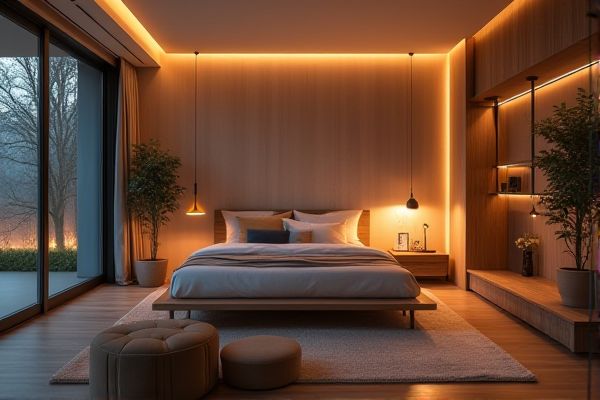
Integrated LED lighting offers a sleek, energy-efficient solution with longer lifespan and seamless design, eliminating the need for bulky fixtures and simplifying installation. Discover how choosing between integrated LEDs and plug-in lamps can impact your space's ambiance, functionality, and energy costs by reading the rest of this article.
Table of Comparison
| Feature | Integrated LED Lighting | Plug-in Lamps |
|---|---|---|
| Installation | Built-in, requires professional setup | Simple, plug into any outlet |
| Energy Efficiency | High efficiency, lower energy consumption | Varies, often less efficient than integrated LEDs |
| Design Flexibility | Custom, sleek and flush with surfaces | Portable, varied styles and sizes |
| Lifespan | Long lifespan (25,000+ hours) | Depends on bulb type, generally shorter |
| Maintenance | Low, integrated system replacement needed | Easy, replace bulbs or lamps as needed |
| Cost | Higher upfront cost, lower long-term expense | Lower initial cost, potentially higher over time |
| Lighting Quality | Consistent, customizable color temperatures | Varies, dependent on bulb and fixture |
| Portability | Fixed in place | Highly portable and repositionable |
Introduction to Integrated LED Lighting and Plug-in Lamps
Integrated LED lighting offers seamless design integration and energy efficiency by embedding light sources directly into fixtures, eliminating the need for external bulbs or lamps. Plug-in lamps provide flexible, portable illumination options that can be easily moved and plugged into standard outlets, catering to varied lighting needs and spaces. Your choice depends on whether you prioritize sleek, built-in aesthetics or adaptable, movable lighting solutions.
Design Differences: Built-In Versus Portable Solutions
Integrated LED lighting features built-in fixtures seamlessly incorporated into ceilings, walls, or furniture, offering minimalist and sleek design aesthetics that eliminate clutter. Plug-in lamps provide portable solutions with flexible placement options, allowing you to easily adjust lighting according to your needs or room layout. The choice between fixed integrated LEDs and versatile plug-in lamps fundamentally impacts spatial design, lighting functionality, and overall interior style.
Energy Efficiency and Power Consumption
Integrated LED lighting offers superior energy efficiency by using advanced semiconductor technology that consumes significantly less power than traditional plug-in lamps with incandescent or fluorescent bulbs. These systems convert a higher percentage of electricity into light, reducing your overall power consumption and lowering electricity bills. Choosing integrated LED lighting helps minimize energy waste while providing consistent, long-lasting illumination.
Installation and Flexibility Compared
Integrated LED lighting offers seamless installation, often built directly into fixtures or ceilings, reducing clutter and eliminating the need for extra wiring. Plug-in lamps provide greater flexibility, allowing you to easily move and reposition the light source to suit changing needs or room layouts. Your choice depends on whether you prioritize a clean, permanent setup or adaptable, portable lighting options.
Lifespan and Maintenance Requirements
Integrated LED lighting offers a significantly longer lifespan, often exceeding 25,000 hours, compared to plug-in lamps that typically use bulbs lasting around 1,000 to 2,000 hours. This extended lifespan reduces the frequency of bulb replacements, minimizing maintenance efforts and costs. Choosing integrated LED lighting ensures Your space remains consistently illuminated with lower upkeep demands.
Lighting Quality and Performance
Integrated LED lighting delivers superior lighting quality with consistent brightness and color accuracy compared to plug-in lamps, which often rely on replaceable bulbs that can degrade over time. Your space benefits from energy-efficient performance, longer lifespan, and reduced maintenance costs due to the advanced heat dissipation and built-in controls of integrated LEDs. Enhanced dimming capabilities and uniform light distribution make integrated LED systems ideal for creating customizable and comfortable illumination environments.
Cost Analysis: Initial Investment and Long-Term Savings
Integrated LED lighting typically requires a higher initial investment compared to plug-in lamps due to installation and fixture costs, but it offers significant long-term savings through superior energy efficiency and reduced maintenance expenses. Plug-in lamps have lower upfront costs but often lead to higher electricity consumption and more frequent bulb replacements, increasing overall expenses over time. Your choice should balance initial budget constraints with long-term cost benefits, favoring integrated LED lighting for sustained energy savings and durability.
Aesthetic Impact and Interior Design Options
Integrated LED lighting offers sleek, minimalist designs that seamlessly blend into ceilings or walls, enhancing modern interior aesthetics without visual clutter. Unlike plug-in lamps, which can disrupt spatial harmony and limit placement flexibility, integrated LEDs provide uniform illumination and customizable color temperatures that complement diverse design schemes. This embedded lighting solution maximizes clean lines and open spaces, supporting cohesive decor and sophisticated ambiance creation.
Environmental Sustainability Considerations
Integrated LED lighting significantly reduces energy consumption by using advanced semiconductor technology that lasts up to 50,000 hours, minimizing the need for frequent replacements and reducing electronic waste. Plug-in lamps often rely on less efficient bulbs and generate more waste due to disposable components, impacting landfill volumes and resource depletion. Your choice of integrated LED lighting supports environmental sustainability by lowering carbon footprints and promoting eco-friendly energy use.
Choosing the Right Lighting Solution for Your Space
Integrated LED lighting offers a streamlined, energy-efficient option with longer lifespan and minimal maintenance compared to plug-in lamps, which provide flexibility and ease of installation. For permanent, modern designs, integrated LEDs reduce clutter and enhance architectural aesthetics, while plug-in lamps suit rented spaces or temporary setups where mobility is key. Evaluating room size, lighting needs, and budget will determine the ideal choice between fixed, built-in illumination and versatile, portable lamps.
 homyna.com
homyna.com